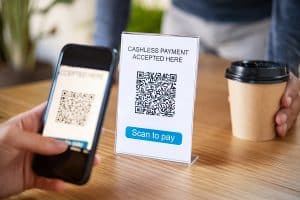This guide explains how to get started with Click to Pay and why you should add this service to your eCommerce business.
Our content reflects the editorial opinions of our experts. While our site makes money through
referral partnerships, we only partner with companies that meet our standards for quality, as outlined in our independent
rating and scoring system.
Click to Pay is a service that aims to make it easier for customers to pay online with credit cards. Click to Pay is offered by a consortium of Visa, Mastercard, American Express, and Discover. With a single Click to Pay account, a customer can store payment information for all of their credit and debit cards that belong to these four card networks.
This guide breaks down everything you need to know about Click to Pay, including whether Click to Pay is safe, how Click to Pay works, and the benefits of using Click to Pay.
What Is Click To Pay?
Click to Pay is an online checkout that allows customers to pay with a single click of a button. Customers can choose which card to use from their stored payment methods and then complete the transaction quickly and securely.
How Does Click To Pay Work?
Click to Pay allows consumers to add their payment cards to a single account and pay for online purchases with Visa, Mastercard, American Express, Discover, debit cards, and prepaid cards. It works on any website or mobile app.
Ultimately, Click to Pay replaces similar programs offered by major card brands, including Amex Checkout, MasterPass, and Visa Checkout. The major disadvantage of these previous programs was that they each only worked with one card brand, potentially requiring customers to sign up for multiple accounts.
Click To Pay Solves A Major Problem With Online Payments
Click to Pay offers a convenient and secure way to make online purchases by creating a single sign-in account that works with multiple payment cards across many online retail websites and can be used with virtually any device with an internet connection.
One-click services, such as Click to Pay, help reduce online cart abandonment. Click to Pay also allows the major credit card companies to compete directly with other one-click services and digital wallets offered by tech companies, such as Apple Pay, PayPal, and Google Pay.
Is Click To Pay Safe For Online Payments?
Click to Pay offers a level of security on par with what’s offered by EMV credit card chips and digital wallets, such as Apple Pay. And, as we touched on earlier, the security standards for Click to Pay are maintained by the same organization that maintains EMV security standards. The primary security features include:
- Tokenization: Tokenization replaces credit card information with random letters and numbers when transmitting that data between systems. The token is ultimately worthless outside of the context of that transaction.
- 3D Secure: 3D Secure is a fraud prevention service owned by Visa that provides an additional layer of security for online transactions before final authorization.
- Security Code: When you sign up for Click to Pay, you’ll receive a six-digit security code. To make a payment from your account, you’ll enter that number.
How Does Click To Pay Work For Merchants?
Generally, to use Click to Pay as an eCommerce merchant, you’ll need to add a Click to Pay payment API to your website so that your customers will see the Click to Pay icon as one of their payment options at checkout.
In most cases, you can obtain the necessary code from your current merchant account provider. Both Stripe Payments and Braintree provide some information about Click to Pay in their developer documentation for those trying to add the service to their hosted payment page.
Braintree also mentions that the program is currently on a limited release, so small businesses might have to wait a while longer before it becomes available to them.
Are Click To Pay Transactions Different From Credit Card Transactions?
Transactions processed using Click to Pay will incur the same interchange fees and processing costs as a credit card transaction of its type normally would. You’ll also have to be concerned about chargebacks and PCI compliance requirements, just like you would with any other payment method.
The bottom line is that adding Click to Pay will almost certainly increase your sales while costing you nothing to implement. It’s a rare win-win situation where both you and your online merchant account provider should make more money by using the service.
Are There Any Disadvantages To Offering Click To Pay?
While Click to Pay is a low-risk, high-reward prospect, there are some minor disadvantages.
Cons
- It requires some extra work to implement. This may change as payment processors streamline implementation in the future.
- Customer utilization may be low until it catches on.
- If your customer base tends to be older, adoption may be slow.
How Does Click To Pay Work For Consumers?
To use Click to Pay, you will need to sign up for a Click to Pay profile. Mastercard and Visa allow customers to create a Click to Pay profile ahead of time directly from their websites. Your issuing bank might also offer a sign-up process from the website you use to manage your credit card.
American Express and Discover don’t have dedicated sign-up pages at this time. Instead, you can complete your Click to Pay profile when you make your first purchase using the service.
When you check out with a participating merchant, simply click on the Click to Pay icon (see above). If you already have a profile set up, you just have to choose which of your credit cards you’d like to use.
How To Sign Up For A New Click to Pay Account
If you don’t already have a profile set up, the steps to do so are pretty straightforward:
- Type in your email address when prompted. This will be your Click to Pay User ID.
- Enter your mobile phone number.
- Enter your credit card information for each card (card number, expiration date, and security code).
- Enter your current billing address.
- Once this information is submitted, you’ll receive a six-digit verification code via email. Enter this code to complete your profile setup. That’s it!
Note that if you already had set up an account with one of the older services that Click to Pay replaced (e.g., Visa Checkout), this information should have been automatically transferred to your new Click to Pay profile. You should confirm that all information is correct, especially if you haven’t used the old service in a while.
The Bottom Line On Click To Pay
Click to Pay is still a fairly new service, but adoption seems to be growing quickly among retailers.
Should you be one of them? We would definitely say yes. There’s little downside beyond a small amount of work upfront. It also offers a clear advantage over proprietary payment methods, as Click to Pay isn’t restricted to just merchants who are using the proprietary platform.
If you’re interested in joining the eCommerce merchant game, you’ll need an eCommerce platform to manage your online storefront. The best eCommerce merchant accounts offer online sellers multiple ways to accept payments, including Click to Pay options.
Frequently Asked Questions About Click To Pay
Does Click to Pay charge a fee?
Click to Pay does not charge any additional fees. Normal eCommerce transaction fees do apply, however.
Is Click to Pay a wallet?
Click to Pay functions as a digital wallet for any credit or debit card offered by a member of the EMVco association.
What is Visa Click to Pay?
Click to Pay replaces Visa Checkout, the brand’s previous attempt at a one-touch payment solution.
What is Mastercard Click to Pay?
Click to Pay replaces Mastercard Masterpass, the brand’s previous attempt at a one-touch payment solution.












